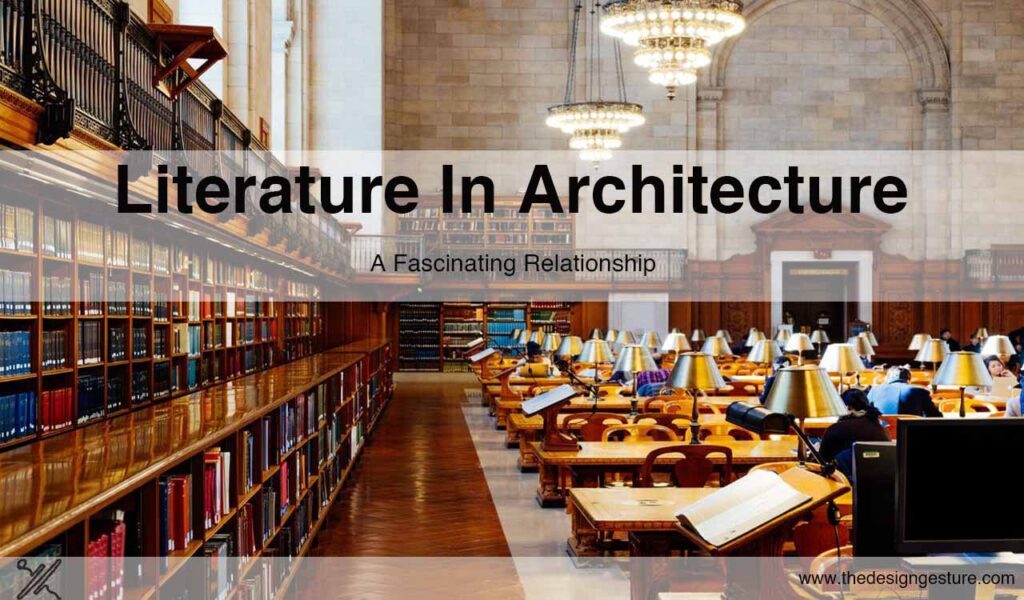Table of Contents
What are the odds of framing a sentence with Literature and Architecture?
Is literature the predecessor and architecture the successor?
Well, architecture and literature in both areas of study end with the suffix ‘ure’, which is added to translate any word into a noun, to express an action, function, or result in the particular field of study. Architectural or literary expression is classified into a wide range; Dancing, Music, Painting, Sculpture, all limited to either in theme or an emotional range.
All these arts are richer than either literature or architecture, but somehow architecture has an upper hand with the third element of enacting upon our bodily senses. Whereas, literature makes us experience the world through the power of visualization expressed through Words. It is an inherent part of our daily regime, to read, write and experience things. Thus, both literature and architecture are highly influential in our lives in some other ways.
So, now the question arises of why relating distinctly different fields of study together?
Written speech moves us towards visual space. Both these areas have many similar aspects to deal with which personify the grandeur of humankind. The only misleading aspect is when people differentiate prose and poetry similar to differentiating architecture and construction, which is understood only by the typographer or the stonemason, but not by individuals like us. To deal with the greatest modes of expression-Architecture and literature- as if Art and expression were synonymous to each other, although they are not as all art is expressive.

Similarities in the two fields of study:
Space
Everything happens in the presence of gravity, in a dedicated environment which in simpler terms can be defined as space. For both Literature and Architecture, space is where the viewer, user, reader, and enactor perceive its environment through the bodily senses. This is the only way to experience. For literature, this space becomes the atmosphere of the story built by the author, where the reader finds himself loitering.
But in architecture, space is the basic element where the architect starts the design. Sometimes it’s the inspiration for the entire project. This is where the user can actually experience the thoughts and ideas of the designer in three dimensions.

Readers and Users
In Literature, the writer goes by two approaches, by defining his audience or by making a new audience. Whatever the writer plans are for connecting to a set of audiences and thus inspiring the Reader, which makes an important aspect of consideration during creation of new content. Whereas in architecture, the most important aspect of designing is the user group. This is for whom the structure is going to be designed and developed. Both Literature and architecture inspire its Reader and User, thus impacting their lives.
Imagination and Visualisation
In Literature, the writer sows a seed of an idea for the narrative to make the reader imagine a world fictionally. Whereas in Architecture, the Architect designs the experience through visualization, making the space for the user-defined according to his expectations. Thus, both have the same method of starting the idea and converting it into a piece of wonderment.

Theme and Concept
In Literature, the writer defines the theme of the story or prose, to begin with. This is the most important step because this defines the overall idea and process of the story from the perspective of the author for the reader. In Architecture, concept shapes the idea to material grounds, by different approaches.
Like handling sustainability, economy, environmental psychology or geometry, volume, light, sound, etc. Thus, it tackles problems with a specific concept. Both these words, i.e., Theme and Concept, are intangible aspects, as they are set forth to move in a certain desired direction, thus limiting the mountain of refrainment.
Characters and Structural Elements
Literature is judged by the characteristics of the character used in the plot. Only when a character defines and relates to the audience it is being accepted on a wide scale. Similarly, the structural elements of a built mass define the character of not only the architecture but the personality of the building and its users. Thus, making the characters strong and aesthetic can certainly make a difference in the story of literature and architecture.

Perspectives
In Literature, the perspective of looking towards the plot, of the characters towards each other, of the author towards the audience, everything is a magnificent idea bought into one perspective. Whereas in architecture, the idea in perspective of a story or sequence with a plot or horizon sets understanding of the world in a more visual way. Architecture is our primary sense in relating us with space and time and giving these dimensions a human measure.
Storytelling
Irrespective of the field of study, both literature and architecture aim to narrate a story through words or physical manifestation of thoughts and experiences. The story is the way people relate to their memories or create fresh memories, which paves the way to make their everyday mundane life exciting. It engages and creates an interactive dialogue with the user with the writer and the designer.
Memories
Both Literature and architecture are means to create memories for humans. One makes it possible through power of words and the latter creates it through space, along with the bond which the user shares with his/her space. The act of creating memories technically occurs as a reaction to stimuli in a specific pattern when the neurons are reactivated, and the same happens when the user or reader re-experiences it through visiting the structure or re-reading it again.
Inspiration
Both these arts in some or the other way inspire other art forms and traditions. This results in the formation of a movement or a series of important revolutions. Literature written in a certain time frame reflects the ideology and perspectives of people in the particular era and so does architecture. Every few years, architecture revolutionized cities into canvases of art ready to portray the evidence of stories and experiences.
This tradition continues even today and will never be outdated, the simple reason being: ‘Nothing era,Original’ everything is inspiration borrowed from the like-minded ideas worth appreciating.
Literary criticism and Architectural criticism
Where criticism means non-biased appreciation or depreciation. Before the invention of printing mediums, the built bricks, and stones answered for the printed words in the scheme of build mass, i.e., Architectural style. We now can distinctly read the buildings and understand the civilization more efficiently than by reading their few stilted books. This scenario has developed nowadays, as our books reflect the best through the language of words placed with distinct emotions.
Dissimilarities
Literature is purely the design and play of words. It is every other brain’s capability to decipher its unique pattern and decode its basic nature. It is an ability to create a dialogue with the thoughts, opinions, emotions, and ideas of the writer. Words and sentences play a tool to serve the link between the author and the world of readers.
Architecture is more of a visual language, through aesthetics bought from shapes, volumes, material, texture, and many more things. It tries to combine the elements to display certain experiences to the end-user. It deals more with the social, political, and visual aspects of humankind. Leaves a strong footprint and base for future developments.

Conclusion
Architecture and literature are interdependent on each other, both in one or many ways influence each other’s existence, thus leading to the formation of a holistic environment where the users dwell as one. Role of literature is crucial in Architectural theory. Every story starts through the perspective of literature and culminates into story of architecture.
So, what are your views on the two fields of interaction? Do you seem to like any other combinations?




